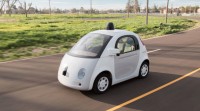CES Panel: Imagining, Building a New Autonomous Ecosystem
January 8, 2019
At a CES panel on “connecting the world,” independent consultant Matt Jones posed the question all involved parties are asking as we move to an autonomous ecosystem. “We need to solve problems for real users,” he said. “It could be providers or cities looking at those questions, of how we’ll deploy and service these vehicles.” He started by looking at the issues from the level of a city — Los Angeles in this case — as represented by Los Angeles Department of Transportation general manager Seleta Reynolds.
“We’re seeing a tipping point on a lot of incredible challenges,” she said, pointing out that mobility is interconnected with a range of social and economic measures for populations. “First and foremost, we’re seeing lots of people getting displaced and disenfranchised, so keeping the city affordable and accessible [is one goal].”

She added that Los Angeles’ bad air quality makes it one of the least healthy places to live in the U.S. Safety is another crucial issue, as 250 pedestrians and bicyclists died on L.A. streets last year. “Unless we take a radical systems approach in solving all those problems through a mobility lens, we’ll fail,” she said. “Autonomy can be part of that solution, but we can’t lean on it to solve all these problems. It’s a great tool, but a terrible master.”
“What I hope happens in the current disruption is that we don’t double-down on the current model,” she added. “Automating SUVs aren’t going to solve challenges. Autonomy is a Trojan horse for thinking differently about everything from vehicle design on up.”
Particle Design chief executive Crystal Rutland suggested that, “when we think about autonomous vehicles, we think about how to imbue them with the right AI to get from point A to B safely.” That’s a good way to start the conversation,” she said. “But it’s just part of a larger conversation of what does it mean for autonomous vehicles to take over jobs. A bus driver, for example, not only drives from Point A to Point B but can handle emergencies and keep people safe [from disruptive passengers].”
Aptiv’s Gretchen Effgen agreed that, “there are behavioral challenges that need to be addressed.”
“You have to design for the passenger to encourage ride-sharing,” she said. “You can start to shift behavior, while hardware/software are evolving in parallel.” STEER founder/chief executive Anuja Sonalker agreed that, “efficiencies are so important.”
“The whole mobility market has shifted to ride- and car-sharing,” she said. “Everyone is trying to reduce the friction.”
Reynolds pushed back on the focus on individual efficiencies. “If we do that, we’ll fail at collective good,” she said. “Uber and Lyft have been incredibly successful at serving people equally, and that’s profound and important to think about and repeat. But it creates more trips that could otherwise be made by biking, walking, transit.”
Hortonworks/Cloudera general manager of automotive affairs Michael Ger agreed that, “it’s a community problem to solve community problems.” “If we’re really trying to optimize the system from a data perspective, we have to ask how we actually work with this broad set of community data to hit the goals from the city’s perspective,” he said. “And as we move the discussion from the car driving itself to the new communities that can be enabled, the security discussion shifts.”

No Comments Yet
You can be the first to comment!
Sorry, comments for this entry are closed at this time.